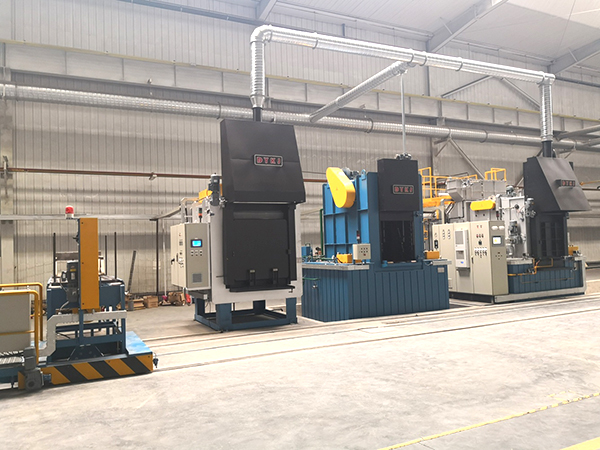400-000-0000

The multi-purpose furnace heat treatment furnace refers to an electric furnace or a fuel furnace for heat treatment and heating of the charge. Common heat treatment furnaces include box-type resistance furnaces, well-type resistance furnaces, gas carburizing furnaces, and salt bath furnaces. Generally, a continuous furnace is used. The workpiece is continuously loaded from the charging door, and continuously discharged from the discharge door through the furnace. Generally, the commonly used conveying method in the furnace is to load the workpiece on the heat-resistant steel guide rail and move it by walking beam or push rod. In recent years, the method of conveying materials by heat-resistant steel conveyor belts has gradually been adopted. In this way, the heat treatment operation is more rationalized, which greatly increases the possibility of automating and unmanaged the heat treatment process.
Due to the variety of heat treatment processes and the shape and size of heat treatment workpieces, the types and structures of heat treatment furnaces are also various. There are many classification methods for heat treatment furnaces. Different classification methods represent different characteristics:
(1) According to the mechanization method: roller hearth furnace, walking furnace, trolley furnace, external mechanized chamber furnace, chain furnace, rotary hearth furnace, vibrating hearth furnace, bell furnace, etc .;
(2) According to the higher temperature points: if the furnace temperature is greater than 1000 ℃, it is a high-temperature heat treatment furnace; 650 ~ 1000 ℃ is a medium-temperature heat treatment furnace; below 650 ℃ is a low-temperature heat treatment furnace;
(3) According to the main types of heat treatment processes: solid solution, quenching, normalizing, tempering, annealing and carburizing chemical heat treatment furnaces;
(4) Divided according to production operation methods: periodic and continuous heat treatment furnaces;
(5) Divided according to heating methods: direct heating methods, such as open flame furnaces; indirect heating methods, such as radiant tube furnaces, muffle furnaces, etc .;
Common heat treatment furnaces include box-type resistance furnaces, well-type resistance furnaces, gas carburizing furnaces, and salt bath furnaces.
(1) Box-type resistance furnace. Its working principle is to use electric current to generate heat through electric heating elements arranged in the furnace, and to heat parts by electric current and radiation. It is a widely used heating equipment in heat treatment workshop. Suitable for heating of steel materials and non-steel materials (non-ferrous metals) for annealing, normalizing, quenching, tempering and solid carburizing. It has the advantages of easy operation, accurate temperature control, protective gas can be passed in to prevent oxidation when the parts are heated, and good working conditions.
(2) Well resistance furnace. The working principle of the well-type resistance furnace is the same as that of the box-type resistance furnace. There are three commonly used furnaces for heat treatment: medium temperature wells, low temperature wells and gas carburizing furnaces. The well type resistance furnace uses cranes to lift parts, which can reduce labor intensity, so it is widely used. The medium temperature well furnace is mainly used for heat treatment such as quenching, annealing and normalizing of dry long parts. Its higher working temperature is 950 ° C. Compared with the box furnace, the pit furnace has better heat transfer. The furnace top can be equipped with a fan to make the temperature distribution more uniform. The vertical placement of the slender parts can overcome the bending deformation caused by the self-weight when the parts are placed horizontally.
The heat treatment furnace has the following characteristics:
(1) The temperature range of the heat treatment furnace is wide. The main purpose is to obtain austenitic steel with good plasticity, and its temperature range is from 900 to 1200 ° C. Due to different process requirements for heat treatment, the temperature can be as high as 1300 ° C and the lowest as about 100 ° C. The temperature difference is so great that the furnace structure is also very different. A furnace temperature higher than 650 ° C is called a high-temperature heat treatment furnace, and the heat transfer is mainly based on radiation, with convection as the supplement. A furnace temperature below 650 ° C is called a low-temperature heat treatment furnace, and the heat transfer mainly depends on convection. The heat treatment requires the furnace temperature to be uniform and avoid excessive local temperature, so the furnace and the combustion chamber of the heat treatment furnace are sometimes separated.
(2) The temperature control of the heat treatment furnace is relatively strict. Heating before pressure processing, the temperature of the metal fluctuates by ten to twenty degrees, which generally has little effect on the quality. However, whether the heat treatment furnace can guarantee the temperature required by the heat treatment process has a great impact on the product quality, and generally does not exceed 3 ~ 10 ° C. The temperature distribution on the section of the object to be heated should be as uniform as possible, and the temperature difference should not exceed 5 ~ 15 ℃. In terms of controlling furnace temperature, electric furnace is superior. In order to achieve the purpose of accurate temperature control, it is better to uniformly arrange the flameless burners and flat flame burners with low power, which is convenient for segmented control, too few burners, too concentrated, and easy to overheat. At the same time, the arrangement of the burner or the electric heating body and the furnace structure should be conducive to the circulation of the furnace gas, so that the temperature in the furnace tends to be uniform. For this purpose, a fan can be used in the furnace.
